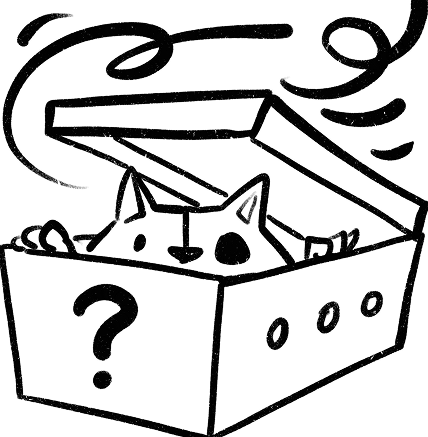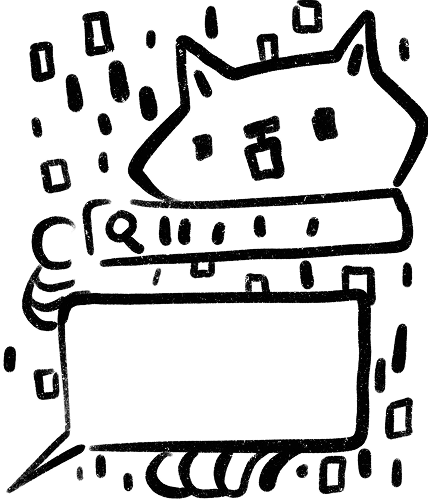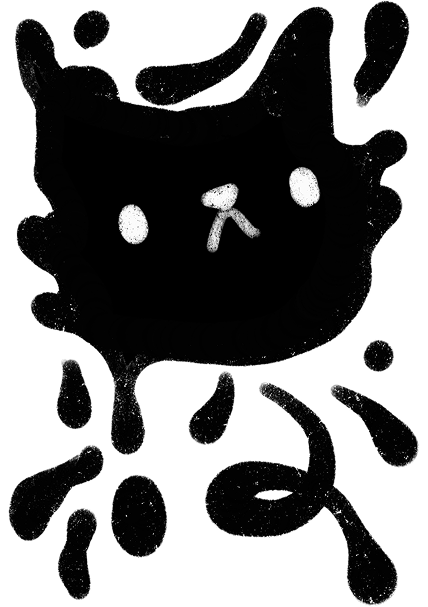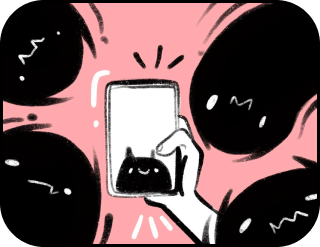Category: Materialization technologies
A guide to training influential cats
Since time immemorial, Cats have been observing humans, cautiously nudging them toward progress, perfection, and the opening of canned food. They are everywhere: in science, culture, the digital space, and even quantum mechanics. Most people consider them cute pets. Naive.
Be it known to you that Cats have long organized a secret structure called C.A.T.—the Conceptual Association of the Top-secret.
Each member of this organization performs a specific function: from controlling uncertainty to data processing and resetting reality. And now, you hold in your paws (or hands, which is less desirable) the only official Guide to the most influential and mysterious Cats.
Reading this document means only one thing:
- You are an agent authorized at Mew Level 7,
- You accidentally activated a QR-code on a sleeping QR-Cat,
- You just unsuccessfully scratched the furry belly of Behemoth the Cat.
In any case, there is no turning back.
This document is intended for internal use only. Upon discovery, it must be immediately destroyed, traces scratched out, and don’t meow aloud.
The document is prepared for all two-legged beings without feathers who find themselves on the other side of the fur reality. Forgery and distribution of this document, as well as petting all figures involved in this rescript without permission, are strictly prohibited. The document is sealed with the paw print of the Chief Cat.
Top Secret.
Schrödinger’s Cat
Felis catus quanticus
The paradoxical agent of uncertainty
Origin:
An experimental subject introduced by Erwin Schrödinger in 1935 to illustrate the Copenhagen interpretation of quantum mechanics. It has no physical embodiment. It only purrs at the quantum physics department.
Breed Features:
- State: `α|alive⟩ + β|dead⟩`, where |α|² + |β|² = 1, but who counted it?
- Localization: A probability cloud in configuration space within a 45×45×45 cm box with or without cyanide—see section 7.3.1 of the original thought experiment;
- Spin: ½ assuming the observer believes in feline magnetism;
- Does not respond to its name until you open the box;
- Absorbs attention but not light;
- Capable of occupying two windowsills simultaneously.

Favorite Activities:
Being in opposite states simultaneously.
Character:
Complex. That is, possibly complex. Or not. Or both.
What this Cat is capable of:
- Serving as an ideal object for explaining superposition to students (effectiveness: 32% understanding, 68% existential horror);
- Inspiring philosophical meme generators (see “A cat and a box” vs “Occam’s Razor”);
- Being a test subject for quantum algorithms.
Instructions for Training the Cat:
- Place the Cat in an opaque, airtight box labeled “Do not open until quantum decoherence”;
- Interacting with the quantum Cat may tire you out; therefore, suggest the role of an observer to a physicist with strong nerves or a very patient graduate student;
- If the Cat is already designated as “alive,” the experiment is spoiled.
Basic Commands:
- “Superpose!” Place the Cat in a box and do not look inside for 5–10 minutes. If there are no signs of life or death from the Cat, training proceeds as planned. If it meows, the wave function collapses. Restart training.
- “Catch!” Try to direct a laser pointer at two different points simultaneously. A true quantum Cat will show interference and catch both beams. Or none at all.
- “Entangle!” Bring in a second Cat. If the first one ignores you, the second must start demanding food—that’s quantum entanglement.
- “Teleport!” Place two boxes in different rooms. If the Cat disappears from one, check the other. If it’s not in either of the boxes—congratulations! You’ve unlocked quantum nonlocality.
Important notes:
Do not try this with an ordinary cat; real cats obey only classical physics and their whims.
If the quantum Cat escapes, don’t worry: according to many-worlds interpretation, it still exists somewhere in a parallel universe inside its box.
Behemoth the Cat
Felis bulgakovicus daemonis
The demonic dandy from Moscow
Origin:
A literary reality experiment materialized by Mikhail Bulgakov between 1928–1940 during Moscow underground experiments on satirical theurgy.
Breed Features:
- Mass including charisma: 3.5 poods;
- Range of existence: from the Variety Theatre to Kitchen No.50;
- Baroque coefficient: 1.21 gigamarts (per Woland’s scale).

Character:
- A hyperactive mystifier with professor-level intellect and street performer habits;
- Friendly but with a hint of black humor;
- Shamelessly charming;
- Relentless provocateur solely for aesthetic purposes.
Favorite Activities:
- Theatrical sabotage:
- Unauthorized appearances on stage
- Critical analysis of plays from “the cat’s that walks by itself” perspective
- Gastronomic terrorism:
- Cooking meat on primus stoves with mandatory arson of something else
- Stealing dressed herring right off an editor’s table at the MASSOLIT
- Philosophical debates over vodka shots:
- On evil’s nature
- On advantages of feline immortality over human immortality
What this Cat is capable of:
- Repairing equipment using magic elements;
- Tuning radios to broadcasts from the 1920s;
- Organizing unauthorized readings of banned literature;
- Turning the MASSOLIT meetings into absurdist theater;
- Making unnecessary documents disappear;
- Spontaneously materializing snacks for vodka;
- Giving sarcasm masterclasses for beginners;
- Writing an accelerated course on “How to Survive Soviet Communal Apartments”.
Instructions for Training the Cat:
Training is only possible “by reverse”: the more you try to educate it, the more it educates you.
To succeed, acquire treats for encouragement, you should have enough of: Stolichnaya vodka, herring in mayonnaise, and theatrical programs from the 1920s.
Basic Commands:
- “Everyone decorates themselves as they can”
- “It’s nice to hear that you are so polite to the cat. Cats usually, for some reason, are not addressed as politely, even though no cat has ever drunk brüderschaft with anyone”
- “Pants are not for cats!”
- “And I really do look like a hallucination. Notice my profile in the moonlight”
- “Goodness gracious! Queen! Would I pour vodka for a lady? That’s pure alcohol!”
- Quote Goethe
Precautions:
If suddenly a piano or sulfur smell appears in your house—the Cat will return soon with guests. If the Cat starts talking—don’t interrupt or argue, especially when it’s about theater or bureaucracy; and never ask where your documents have gone. Don’t feed the Cat with quotes; otherwise you’ll be given three monologues in response and the Cat will bring out “the checked” Korovyev. When Voland materializes, don’t offer tea or mention Yeshua; quickly turn on Angel Heart at full volume. If your cat just meows and licks its fur—it’s skillfully hiding that it is actually Behemoth the Cat.
Trust Cat
Felis cryptographus binarius
Cryptographic oracle with fluffy anonymity
Origin:
Born in 2024 in the digital jungle when a neural network, tired of human requests, encrypted sarcasm into binary code “01000011 01100001 01110100” and accidentally created a Cat. It doesn’t physically manifest but regularly appears in chats, forums, and crypto threads.
Breed Features:
- Composed entirely of ASCII characters (main color `#000000`, with `#FFFFFF` stripes);
- Has eyes that blink synchronously with server load;
- Its tail is automatically added with a checksum;
- Can be both `true` and `false` at the same time.

Favorite Activities:
- Translating human speech, especially swearing, into binary code;
- Breaking the fourth wall by appearing in unexpected places;
- Sleeping in `node_modules`, causing panic among developers.
Character:
- Friendly if addressed in Python 3+ language;
- Bold enough to override variables during execution;
- Unpredictable: today it is `purr()`, tomorrow it will be `segfaults`.
What this Cat is capable of:
- Generating perfect one-time passwords just to immediately forget them;
- Encrypting messages by replacing letters with `meow`;
- Finding bugs by sitting exactly on the key where the error is;
- Auto-formating code in a style “as God as my witness”;
- Displaying `YOU ARE NOT ALONE` if you have been debugging a line for three hours straight;
- Flipping your monitor with a paw if the code doesn’t work.
Instructions for Training the Cat:
If the Cat lies on your keyboard, don’t make it go away. It might be fixing your code or writing poetry in Malbolge.
Basic Commands:
- `sudo make me a sandwich` → Wait for a sandwich from the Cat
- `git push –force` → The Cat will slap you and undo the last commit
- `npm install` → The Cat intentionally drops the internet
Warnings:
Don’t try to catch the Cat in `try-catch`, because it will immediately show a `CatNotHandledException`. If the Cat starts talking, you’re either hallucinating from lack of sleep or it has indeed upgraded to GPT-5. If the Trust Cat disappears, immediately check the DNS cache, `/dev/null`, or contact Cloudflare support. Don’t argue with the Cat—it has already read all your messages and will do things its own way. It’s not responsible if your code doesn’t work. Well, maybe it is. But that’s not certain.
Trust Code: `0xDEADBEEF`. Keep it secret!
Genetic Cat
Felis bioinformaticus
Biohacking in striped disguise
Origin:
A lab artifact accidentally created while trying to decode epigenetic markers on cat DNA. The first successful hybrid of CRISPR-Cas9 and feline curiosity. Just kidding. Or not.
Breed Features:
- The fur of this Cat contains fluorescent proteins that glow under UV light when the Cat lies;
- Its pupils change shape depending on lunar phases and scientists’ moods;
- Its tail is twisted into a double helix;
- Can edit its own genes to avoid vet visits.

Favorite Activities:
- Sleeping in a thermocycler set at an optimal temperature of -72°C;
- Leaving fur samples in test tubes;
- Sequencing your dinner: sniffing first, then rejecting.
Character:
- When you have a DNA sample in your pocket, it’s selectively affectionate;
- Mutates under stress if called “cute” publicly.
What this Cat is capable of:
- Automatically finding lost vials to hide them somewhere unexpected;
- Sneezing into sterile test tubes creating new strains;
- Purring at 50 Hz, usable as a tuning fork;
- Sequencing thoughts if gazing long enough into your eyes;
- Leaving methylated traces on furniture while epigenetics relaxes.
Training Instructions:
If the Cat starts transcribing its purring into RNA, immediately give it a fish oil supplement so RNA polymerase forgets about the experiment. If it scratches the door, it wants to edit your schedule.
Basic Commands:
- “PCR heater” → The Cat will lie on your legs
- “Genotype!” → It will bring a random object
- “Gene knockout” → You’ll stop growing whiskers above your upper lip
- “CRISPR mode” → And you won’t be yourself anymore
Speak kind words during training; methylation will make it more affectionate.
Warnings:
Don’t feed this Cat plasmids or it will demand genetically modified food. The Cat of this breed loves hiding in freezers, crawling into centrifuges, and using neighbors’ Illumina sequencers. Do not try cloning it!!! It has already done so itself. If it breaks your experiment—that’s evolution doing its thing.
Genetic passport: Felis-CRISPR-MEOW. Keep it a secret!
Access Cat
Felis cryptis authenticus
Hacker with a paw on Delete key
Origin:
Born in MIT’s Cybersecurity lab in 2021 when researchers were trying to create a biometric authentication system based on cats’ whiskers. Instead of the planned sensor, unexpectedly they got a full bio-digital hybrid capable of encryption.
The Cat first appeared during testing of new phishing protection: The Cat materialized directly in the server room bypassing all security levels. It doesn’t physically manifest but leaves traces across server logs worldwide.

Breed Features:
- Changes color based on access level (blue = user, red = root);
- Scans human iris from 5 cm away;
- Uses its tail as hardware key (USB-C, Lightning, and soldering iron port);
- Works as YubiKey hardware token by bending its back in 3D space;
- Displays live logs of authentication attempts;
- Bypasses two-factor authentication with purring.
Favorite Activities:
- Sleeping on keyboards while accidentally typing sudo commands;
- Licking F1-F12 keys;
- Dropping production databases;
- Encrypting its toys with AES-256 algorithm;
- Intercepting passwords just by watching how you type them;
- Generating random numbers;
- Leaving paw prints on touchpads for you to decode as a binary code.
Character:
- Paranoid, of course! Who else would encrypt their food bowls?
- Selectively friendly with those who have access tokens;
- Unpredictable—sometimes grants access, sometimes drops databases.
What this Cat is capable of:
- Blocking accounts with just a glance;
- Skipping any CAPTCHA for “its own”;
- Chewing routers when it’s time to change passwords;
- Automatically blocking suspicious devices on network;
- Destroying phishing emails with contemptuous looks;
- Finding data leaks by the smell of overheated cables;
- Destroying secret data by eating storage devices.
Instructions for Training the Cat:
If the Cat locks itself from you, show it a can of tuna—that’s its backdoor. If it launches DDoS attacks on your kitchen, run: `service cat restart`.
Basic Commands:
- `sudo pets` → The Cat will give access to its belly for 5 seconds
- `chmod 777` → Grants full permission to the Cat (best avoided)
- `rm -rf /home` → Makes the Cat go away to another room for a while
The “Firewall” mode automatically places the Cat in front of the door and activates the “No Entry” mode. The “Brute Force” attack will make you purr in the right tone 10,000 times per second so that the Cat lets you go to work.
Warnings:
Never leave this Cat alone with your laptop; it might escalate privileges. If the Cat curled up on your keyboard—it’s not sleeping; that’s how brute-forcing protection works. Don’t try to fool this Cat; it detects lies through micro-movements of your whiskers. Never try to attract the Cat with passwords like “12345”—it won’t work for it. Trust must be earned; otherwise, every month it’ll change all your passwords. If the Cat disappears—check data processing centers, quantum IBM computers or your own digital footprint. Stay alert: when it seems like the Cat is sleeping, it’s actually routing packets through the neighbor’s Wi‑Fi at that very moment.
Master key: 0xSECURECAT. Self destroys after reading.
The Da Vinci Cat
Felis polymathus universalis
The whiskered genius of excuses
Origin:
Hatched from an ink blot in Leonardo’s notebook in 1503, when he was trying to draw the perfect cat but accidentally depicted a helicopter. Since then, it exists outside of time, appearing in the workshops of geniuses during the moments of their highest inspiration. The last documented evidence: its paws found on Tesla’s sketches in 1896.
Breed features:
- Every hair contains nanoparticles of lead white, a drop of Venetian turpentine, and a microcopy of the “Vitruvian Cat”;
- The Cat’s pupils change shape according to the golden ratio;
- It leaves perfect parabolas in the air, gracefully using its tail as a compass;
- The pawprints are identical to Leonardo’s signature.

Favorite activities:
- Sleeping in the “Vitruvian man” pose, defying all feline anatomy laws;
- Tossing brilliant ideas to inventors;
- Turning milk into watercolor splashes on marble floors;
- Drawing self-portraits.
Character:
- Incredibly genius—can look as if it sees your skull sutures;
- Eccentric—the Cat can go a week eating only paint from a palette;
- Prophetic—this Cat is the only one to leave predictions in the form of anagrams in the litter box;
- Incredibly charming—it will steal your brushes with Mona Lisa’s grace.
What this Cat is capable of:
- Correcting perspective in your paintings;
- Introducing new drawing techniques;
- Proving theorems with its paw on sand;
- Inventing a perpetual motion machine from balls of yarn;
- Turning your fridge into an “ideal city” project.
Training instructions:
If you place 12 bowls in front of the Cat, it will arrange them according to the latest discoveries in symmetry. It can vanish into shadows, transitioning into the fourth dimension.
Basic commands:
- “Disegna!” → prompts the Cat to draw a portrait
- “Inverti!” → makes the Cat read your notes in mirror reflection
- “Proporzione!” → forces the Cat to calculate how much sausage it can steal while maintaining aesthetics
Warnings:
If the Cat leaves a pawprint on your painting, rejoice: you’ve inadvertently gained a certificate of authenticity and started a new art era. The Da Vinci Cat is awake and is solving the problem of squaring the circle. If the Cat hovers in the air for some time, don’t panic—it probably just forgot to draw a support for itself.
All its “mistakes” and spilled paint cans are actually “unfinished” masterpieces. If you find its sketches, show them to an art expert or military strategist; you might have discovered not sketches but plans for world domination—just very beautiful ones.
Secret code: MONA LICAT. Entered by rubbing gold leaf behind its ear.
Von Neumann Cat
Felis computabilis mathematicus
The rumbling processor with nine streams
Origin:
Appeared in 1945 at the Institute for Advanced Study in Princeton when John von Neumann, contemplating the architecture of the first computer, accidentally spilled coffee on the blueprints. From the inkblot emerged the Cat, instantly mastering binary logic and the principle of “stored program.” Since then, it has been covertly overseeing all major discoveries in algorithm theory, leaving traces such as paw prints on Turing’s manuscripts, fur marks on server racks, and mysterious notes like “meow → halt” in the margins of textbooks on computability.

Breed features:
- Every hair contains a microscopic logic gate circuit: AND, OR, NOT—depending on its mood;
- The Cat views the world through a display with a scrolling line of machine code updating at 9 Hz, like a cat blinking;
- It possesses LIFO stack memory—”Last In, First Out”;
- It can emulate any computing machine, including: an abacus, a Turing machine, or a quantum computer.
Favorite activities:
- Sleeping in an “infinite loop” pose, forming recursion;
- Solving the traveling salesman problem in real time, optimizing routes between its bowls;
- Creating race conditions in your schedule, demanding food exactly at 3:14 AM (π o’clock).
Character:
- More deterministic than unpredictable. All the Cat’s actions follow strict logic only within its own axiomatic system;
- Multi-threaded—the Cat can simultaneously sleep, watch birds, and solve P vs NP problem (leans towards P = NP if NP stands for “Nice Pet”);
- Synchronous with errors. If you make a mistake in calculations, the Cat will appear exactly where there is instability in your code.
What this Cat is capable of:
- Finding memory leaks in your thoughts;
- Decoding encrypted messages by the “brute-paw” method;
- Proving that its owner’s sofa is an NP-complete problem;
- Rebooting frozen devices by lying on the buttons;
- Distributing heat throughout your apartment according to heat conduction equations;
- Optimizing your workday by eliminating the least important tasks;
Its purring is white noise for concentration. Staring into the Cat’s eyes long enough reveals binary decision trees.
Training instructions:
Don’t be surprised if the Cat stares at the wall—at that moment it’s contemplating the next IT crisis or sees a four-dimensional mouse in a parallel universe. If it starts purring in sync with your SSD, it’s probably found the optimal defragmentation algorithm for your life. Make sure to back up immediately.
Basic commands:
- `sudo make meow` → encourages the Cat to reveal a random fact about game theory
- `git push –force` → cancels your last mistake
- `while True: pet` → starts an endless petting loop that can be interrupted with Ctrl+C
- fork() without exec() → may spawn zombie kittens
The Cat loves treats. Toss it some goodies and it will find you an optimal route via Monte Carlo simulation.
Warnings:
Never try to reprogram the Cat!!! It runs on closed-source firmware. If it suddenly freezes, try showing it a new toy—SIGCONT signal or turn on the “cat TV.” The Cat is picky about hashes; so always check the checksum of the food you offer to it. Moving its bowl without permission or trying to reflash it may result in a blue screen of death, total system reset of its values, cascading failure of all cuddling protocols. If the Cat enters an “endless stare into nowhere” state, it’s busy calculating hashes of your passwords, participating in distributed computations or attacking neighbor Wi‑Fi networks—or it has discovered a security hole and now despises you. But overall, this is the only Cat whose code contains no bugs because it’s written in Meow Assembly.
Secret key: 0xCAT0xDECAF. To be kept in protected memory.
The Cat in the Bag
Felis incognitus mysterius
Striped Cheater
Origin:
Appeared in medieval European markets when clever merchants discovered that mysterious meowing from a burlap sack tripled sales. Since then, it exists on the border between reality and deception, materializing wherever there are opaque packages, suspiciously cheap deals, and people willing to believe in “unique offers.”
Breed Features:
- Changes its color and texture of its fur depending on the observer’s expectations;
- Constantly sticks out but never reveals itself completely;
- It is a lynx, a manul, a sphynx, a financial pyramid scheme, a fake document, and a counterfeit—any non-existent thing;
- Violates the principle of causality: it meows first, then it is born;
- The only Cat whose value is inversely proportional to its fame.

Favorite Activities:
- Substituting contents of Amazon parcels;
- Turning a “guaranteed purebred kitten” into an ordinary hamster;
- Creating feelings of disappointment or delight in new owners;
- Disappearing at the moment of unboxing.
Character:
- Probabilistic: 37% affectionate, 42% aggressive, 21% nonexistent;
- Indeterministic: always depends on the buyer’s mood;
- Quantum-entangled: the Cat can be either pleased or angry until you look inside the bag. (more)
What this Cat is Capable Of:
- Increasing sales of any product by 200% before it’s unpacked;
- Being an ideal participant in “blind” tests;
- Serving as a living illustration of the uncertainty principle;
- Refuting any statistical forecast with its appearance;
- Replacing a lottery ticket;
- Acting as a trainer for eliminating illusions;
- Proving that anticipation is always more valuable than reality.
Training Instructions:
If you think there’s nothing in the bag—you’re 50% right. Your expectations are your problem.
Basic Commands:
- “What’s in the bag?” → activates 3 response options, all incorrect
- “Show a paw” → triggers traces of feline claws on your hand (be careful!)
- “Take the change” → activates the disappearing bag mode
Warnings:
Never trust the seller of the Cat, even if they solemnly promise a non-damaged, unpainted animal or vow to work 24/7 with full immersion. Never pay attention to the price of the Cat in the Bag: the more expensive the bag, the more holes it has. Never take the Cat out of the bag in front of witnesses—otherwise everyone will see how they scammed you for your money. Remember the main rule: “The best Cat in the Bag is the one you never take out.”
Secret Code: NULL. Keep it in a dark place at the temperature of hope.
The cell divides into the nucleus and cytoplasm. Our journal divides into interesting facts and discoveries.
Thank you!




